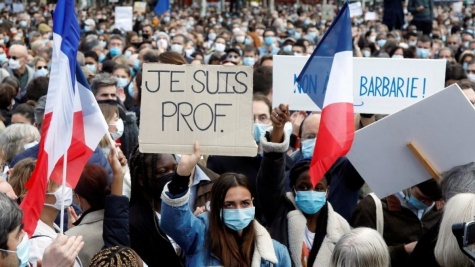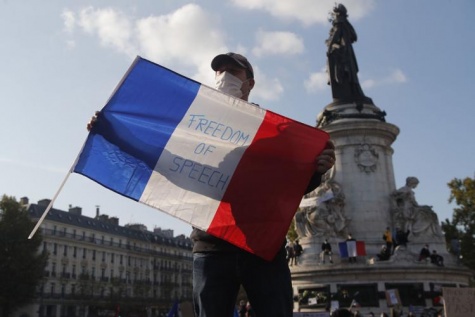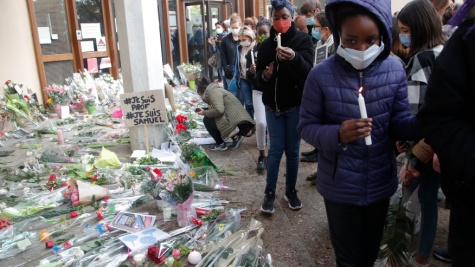
By Eden Milligan | Head Editor
October 23, 2020
On Friday, October 16, a French middle school history teacher at Collège Bois-d’Aulne was beheaded on his way home from work. His fatal crime? Showing his students a cartoon.
The man who killed Samuel Paty was quickly identified as Abdoullak Abouyedovich Anzorov, an eighteen-year-old Islamic extremist. Though Anzorov was shot dead by the French police just minutes after the murder, thousands of people in France still long for a deeper justice. Over a week after the tragedy, all of France is still mourning Paty’s death. The country is rising up in solidarity with Paty, and teachers across France are expressing their fear to live in a place where an enlightened lecture could get them killed.
However, teachers are not the only ones who have to be afraid; French muslims are concerned that a rise in Islamophobia connected to the attack may only make innocent Muslims a target for fear and hatred. Many in France think Islamic Extremism is the heart of the issue, and eradicating it will again create a safe environment that nurtures freedoms of speech and expression. Others think the teacher’s act was unjustifiable and harmful, and in the future, people should be more mindful of different religions so as not to seemingly target any group. In any case, Paty’s death and the conditions that surrounded it have brought up a larger issue that is ever-important in France and around the world; where does the boundary lie between freedom of expression and flagrant blasphemy?
Eleven days before Samuel Paty’s murder, he showed his class of eighth-grader students a cartoon produced by the French magazine Charlie Hebdo. In France, Charlie Hebdo is known (famously or infamously) for the harsh and overt nature of its satire against just about every aspect of society—from religion, to popular culture, to politics. However, what really made the magazine gain recognition was a string of cartoons released in 2011 and 2012 that displayed the prophet Muhammad in an offensive way. Since the release of these cartoons, Charlie Hebo has been a target for ongoing attacks.
“We’ve faced a terrorist attack almost every two months for the last eight years now,” Caroline Fourest, a former journalist at Charlie Hebdo, said.
In November 2011, the same month that the first cartoon with Muhammed on its cover was released, the Charlie Hedbo office was firebombed, and its website was hacked. On January 7 2015, twelve people were killed at the Charlie Hebdo office, spurring a sweeping movement of sympathizers across France that used the slogan “je suis Charlie” (I am Charlie) to show their support.
After a history of violence related to Charlie Hebdo, many people are horrified that five years after the last fatal attack, the violence is surfacing again. “[Hearing about the recent attack] made me sad because I used to live in France, and when the Charlie Hebdo attacks happened, and there were other attacks at schools closed near where I used to live, my school went into a mini-lockdown, and it made me remember those times. That was bad. It just sucks to hear, and I think it will raise tensions back in France” junior Joseph Sansac de Traversay said.
The recent attack bears harrowing similarities to the others over the last several years. The perpetrators in the 2015 massacre, like Anzorov, claimed that they were proud to have “avenged the prophet” Muhammed. It seems then that as long as these cartoons exist, though horrifying to admit, the attacks may never stop.

It may seem odd that cartoons linked to so much violence and destruction would still be in circulation–even more so that they were shown at a school. However, the controversial nature of these cartoons is exactly what makes them so important in France. They represent one one of the most crucial values of the republic, and of democracy as a whole: liberty, the power to do as one pleases without restraint.
The Charlie Hebdo cartoons were created to bring up difficult matters in a provocative way, to inspire change through satire. A dedicated history teacher, Paty often encouraged his students to engage in debate over controversial topics. He never intended the images to be taken as an attack on Muslims; he genuinely presented them as a means to encourage debate over freedom of speech. Also, according to his students, he clearly stated that any student who felt uncomfortable because of the cartoon may leave the classroom. Though none of Paty’s students took offense, the situation quickly turned hostile when an angry father heard about the cartoon from his daughter, and posted on social media demanding that Paty be fired or somehow punished for his disrespect of the Islamic religion. The father posted the locations of the school and information about Paty, which fell into the hands of extremists like Anzorov, who sought to take their anger and disdain to the next level.
Currently, seven people (including the father who created the hostile social media post) are facing charges for involvement in the murder. Among these are two young students, who accepted money from Anzorov in exchange for identifying the teacher. Allegedly, these students were told that Anzorov merely wanted to humiliate Paty and force him to apologize, and they did not foresee a murder.
These seven are not the only Muslims in France being targeted because of the recent murder. Emmanuel Macron, the president of France, has announced increased support for efforts to combat extremism in France. This includes dozens of raids on Muslim homes in an effort to locate extremists who may have been in connection with Anzorov. These measures have created fear for many Muslims in France, who are worried that the recent attack will increase prejudice against them.
The tense climate around religion in France that has contributed to fear and division in the country is greatly influenced by a pillar of their beliefs: secularism. Secularism, or laïcité, is the belief that religion should be a private matter that is kept as hidden as possible. This is especially emphasized in French public schools. In France, it is strictly against dress code to wear a hijab to school, just as it is not allowed to wear a large Christian cross necklace. This has been a point of conflict for years, because veils like hijabs are often seen as a key characteristic of Muslim identity. Though some argue that enforced secularism limits people’s freedom of expression, laïcité is actually meant to uphold democracy, and decrease division within the country.
Though the emphasis on secularism and suppressing religious differences in public school is fairly unique to France, the basis of the Charlie Hebdo issue is not. Teachers around the world deal with the same dilemma that Paty faced of whether it is justifiable to bring up topics that are offensive to some to create critical and insightful students.
“I am a strong believer in talking about controversial and difficult topics, though it is certainly important to establish an environment in which students feel safe and understand how to discuss such topics in a sensitive and thoughtful manner,” French teacher Madame Alizadeh said. As an IB teacher, Alizadeh puts emphasis on encouraging critical thinking and intercultural understanding. “I think it’s important that we ask students tough questions and force them to consider unintended consequences of their beliefs, or perhaps, the possible contradictions in their belief systems.”
On October 21, President Macron posthumously awarded Samuel Paty with the French legion d’honneur, the highest award given in France, effectively making Paty the heroic face of freedom in the republic. In a speech fondly directed at Samuel Paty himself, Macron said, “We will continue this fight for liberty and for reason of which you have now become the face, because we owe it to you. Because in France, sir, the lights will not go out.”


Leave a Reply